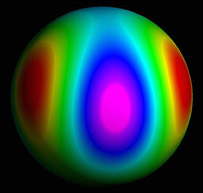Something from Nothing, our Universe?
"Don't imagine outer space without matter in it.
Imagine no space at all and no matter at all. ...
To the average person it might seem obvious that
nothing can happen in nothing.
But to a quantum physicist, nothing is, in fact, something.
...
Quantum theory also holds that a vacuum, like atoms,
is subject to quantum uncertainties.
This means that things can materialize out of the vacuum,
although they tend to vanish back into it quickly....
this phenomenon has never been observed directly."...
PROBLEM! If nothing is something, it would seem to logically
follow that there is NO nothing, there is only something!
Well, problem solved, the reason we can't get something from nothing is because
there never was a nothing, there has always been only something!
But, what was the nature of the something that preceded our universe,
that we mistakenly thought was nothing?
Maybe we should do further research!
"Where do the laws of physics come from?" (Guth) pauses...
"We are a long way from being able to answer that one."
"We are a long way from being able to answer that one."
Ref: Brad Lemley, "Guth's Grand Guess," Discover (vol. 23, April 2002). p 35 & p 38
Notes:
a) One law of quantum mechanics states that the smaller the time interval, the
smaller the probability for a quantum event. At the moment of the beginning, the
universe's time interval is zero. (Time starting at the beginning event.) With a zero
time interval, the probability for a universe to pop into existence through some
kind of quantum event would equal zero.
b) Another quantum mechanic law stipulates
that the bigger the mass brought into existence through a quantum fluctuation
in the space time-fabric, the faster the mass must return to the space-time continuum.
For something as massive as our observable universe, the return time would be briefer
than 10-120 seconds, an extremely short time, much less then the blink
of an eye.
c) Could quantum mechanical laws have been different when the universe was
much younger than a fraction of a second? Yes, possibly they could. However, to date
no physical evidence has been discovered for this possibility.
Well then, how are all these theories justified?
It is, of course, a big step from the spontaneous and uncaused appearance of a subatomic particle-something that is routinely observed in particle accelerators-to the spontaneous and uncaused appearance of the universe. But the loophole is there. If, as astronomers believe, the primeval universe was compressed to a very small size, then quantum effects must have once been important on a cosmic scale. Even if we don't have a precise idea of exactly what took place at the beginning, we can at least see that the origin of the universe from nothing need not be unlawful or unnatural or unscientific.
Ref: What Happened Before the Big Bang?, Paul Davies, from http://www.fortunecity.com /emachines /e11 /86 /big-bang.html
WOW!
What a loophole!
Not just one big enough to drive a truck through!
But one to create a universe with!!
What a loophole!
Not just one big enough to drive a truck through!
But one to create a universe with!!
"Theorist John A. Wheeler (Institute for Advanced Study)
has long advocated that at the Planck scale, space-time
has a complex shape that changes from instant to instant.
Wheeler called his picture "space-time foam" - a sea of
quantum black holes and worm holes appearing and vanishing
on a time scale of about 10^-43" seconds. ...
Space-time foam has also been implicated as the spawning
ground for baby universes. In several theories explaining
the cause of the Big Bang and what came before, big bangs
can bud off from a previously existing space-time, break
away completely while still microscopic, and inflate with
matter to become new universes of their own, completely
disconnected ("disjoint") from their space- time of origin.
...
Yet there are problems. The amount of latent energy in
the quantum fluctuations of space-time foam is staggering:
10^105 ergs per cubic centimeter. This amounts to 10
billion billion times the mass of all the galaxies in
the observable universe packed into every cubic
centimeter! Fortunately, Mother Nature seems to have
devised some means of exactly canceling out this
phenomenon to an accuracy of about 120 decimal places.
The problem is that we haven't a clue how. ...
REALITY CHECK
Some physicists have begun to throw cold water on these
fantastic ideas. For instance, Matt Visser (Washington
University) studied the mathematical properties of
quantum worm holes and discovered that, once they are
formed, they become stable: they can't foam at all.
Kazuo Ghoroku (Fukuoka Institute of Technology, Japan)
also found that quantum worm holes become stable even
when their interactions with other fields are considered.
What Wheeler called space-time foam may be something else
entirely." ...
Ref: Space-Time: The Final Frontier Written by Sten Odenwald. Copyright (C) 1995 Sky Publishing Corporation. See February 1996 issue. from http://itss.raytheon.com /cafe /cosm /vacuum.html
Was it a "point type singularity" or a "sheet type singularity"? Another new "Big Bang" model, and there are many, has been unveiled termed the "ekpyrotic (out of fire) model". According to this model, two ten-dimensional flat sheets of space-time stand parallel to each other. At some point, a random fluctuation in the space-time fabric of one of the sheets peels off a membrane that floats toward the other sheet. When the floater hits the other sheet a big bang occurs, leading to the release of energy and matter from the unfurling of space curvature, and, later, a universe of galaxies and stars. This model proposes a different set of gravitational waves distinct from other models, so future measurements of gravity waves may be able to in some ways indicate a thumbs up or thumbs down for this model.
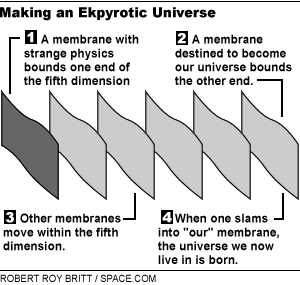
Ref: Charles Seife, "Big Bang's New Rival Debuts with a Splash", Science 292 (2001): 189-90
Robert Neil Boyd says "It appears that the description of Steinhardt, et al, of "...a collision between two 4-dimensional membranes in a 5 dimensional subspace of the 11-dimensional space of a superstring M-theory", require mechanisms involving manifestations of forces which have never been directly observed in Nature. How can there be a "collision" of these 4D "membranes", and secondly, why must such "collision" result in the production of energy sufficient to make an infinite volume 3D universe? It seems to me just as likely that the 4D volumes would intersect without any large-scale interactions, or perhaps with no interactions at all."
Ref: Ekpyrotic Universe (c) Robert Neil Boyd from http://www.rialian.com /rnboyd /ekpyrotic.htm
When a new theory appears, proposed to patch some of the holes and problems with the theories it is designed to replace, wait a little while and the anti-theories will soon appear. The news media will most often follow up immediately a clip or speech from a Republican with equal time for the Democrat, but that is not always the way it works in "science" news, time for the opposition theories will seldom be granted. Fortunately, we now have the free forum of the internet, and if one is diligent in their search, they will be able to find the opposing views for consideration. And believe it or not, there are rational thinking people who do not agree with the "Big Bang theories"!
If you accept that all time started with the beginning of our universe?
Question: What happened before the big bang?
Then the politically correct answer is: NOTHING.
Then how can "scientists" tell us
what existed before the "Big Bang"
and what caused the "Big Bang"??
Definitions of the scientific method use such concepts as objectivity of approach to and acceptability of the results of scientific study. Objectivity indicates the attempt to observe things as they are, without falsifying observations to accord with some preconceived world view. Acceptability is judged in terms of the degree to which observations and experimentations can be reproduced. Scientific method also involves the interplay of inductive reasoning (reasoning from specific observations and experiments to more general hypotheses and theories) and deductive reasoning (reasoning from theories to account for specific experimental results). By such reasoning processes, science attempts to develop the broad laws that become part of our understanding of the natural world.
Then do the following observations that have been proposed as four excellent reasons for believing in the big-bang theory appear sufficient? (from http://kosmoi.com /Science /Cosmology /BigBang)
a) The apparent expansion of our present universe measured by the "redshift".
While Hubble's discovery was revolutionary, his observations were flawed. His observations indicated the universe was expanding so quickly that it was born only 2 billion years ago, yet geologists had already dated rocks on Earth at more than 4 billion years old. Later refinements and observations put the age of the universe at 10 billion to 20 billion years. Some recent observations had suggested the answer was closer to 10 billion, which created a new paradox: some stars are older than 10 billion years old, a situation akin to being older than one's mother.
(from http://abcnews.go.com /sections /science /DailyNews /universe990525.html)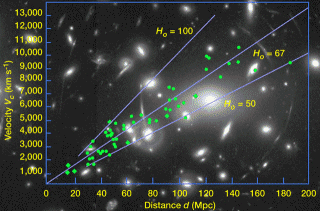
It has been noted that when galaxies appear in physical groupings it appears
that their redshifts differ by whole multiples of 72 km/s! This is a very
strange and unexplained result and only one of many suggestions that
perhaps there is something about redshifts that is not understood.
b) Theoretical calculations predicting that about a quarter of the universe should consists of helium-4, a result which seems to be in good agreement with current observations.
Or, that was until the recent discovery from the Spiral galaxy NGC 891 by ISO (European Space Agency's Infrared Space Observatory) of massive amounts of never before seen molecular hydrogen gas (H2) which possibly provides, at least for this galaxy, a solution to the missing mass problem. "As the Dutch astronomer explains, "it is well established that if there is about 10 times as much molecular hydrogen as atomic hydrogen in the disks of spiral galaxies, then the missing mass problem is resolved. In the case of NGC 891 we find about 5-15 times as much molecular hydrogen as atomic hydrogen"."
(from http://spdext.estec.esa.nl /content /news /index.cfm? aid=18&cid=599&oid=12820)c) A measured cosmic background radiation, which now glows at a temperature just 3 degrees above absolute zero (270 centigrade degrees below freezing).
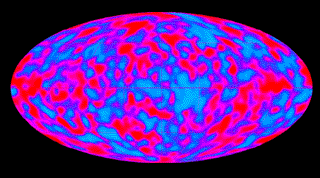
Some scientists are concerned that the back ground radiation is too smooth and that it is possible to explain the cosmic background radiation by other physical effects. The tests go on with the MAP mission to test the following predictions:
1) That there should be, on average, equal numbers of hot and cold spots in the
fluctuations of the cosmic microwave background temperature.
2) That the density of the universe is close to the critical density, and thus
the geometry of the universe is flat.
The generally agreed observational range is
between 0.1 and 0.3 (ie. indicating an open Universe),
although if most of the matter in the Universe was dark,
it could in theory get close to, or equal 1
(the critical density). Therefore the type of
Universe (open, closed or flat) has not been
accurately constrained yet.
(from http://www.vuw.ac.nz /~mackie/ royal_society /nzst_article /universe.htm)
"BOOMerang"(a balloon lifted robotic telescope) data seems to indicate that the
universe is flat to within 10 percent.
3) That the fluctuations in the primordial density in the early universe had the
same amplitude on all physical scales.
(from http://map.gsfc.nasa.gov/m_uni/uni_101tuning.html)
Released February 2003 was the first map from WMAP (Wilkinson Microwave Anisotropy Probe).
"The map is like a baby picture of the most distant light in the universe,
and the findings support the Big Bang theory, scientists say."
"We determine the age of the universe to be 13.7 billion years old to within
200 million years," said principal investigator Charles Bennett of Goddard Space
Flight Center. "That's about a margin of error of only one per cent."
Until now, scientists estimated the universe was 12 to 15 billion years old.
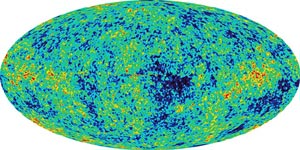

"The study also found
the early universe included four per cent matter in the form of atoms, about 23 percent
unseen dark matter, and about 73 per cent mysterious dark energy, an unknown force
that scientists think counteracts gravity and allows the universe to expand.
"That four per cent is the right stuff," said John Bahcall of Princeton University.
"All the other stuff is goodness knows what."

NASA says the winners are. So now starts the independent peer review process and undoubtedly many opinions of the results will be given in the future.
Looking at the symmetry of the CMB - measures technically called its octopole and quadrupole components - the researchers uncovered a curious pattern.
They had expected to see no pattern at all but what they saw was anything but random.
"The octopole and quadrupole components are arranged in a straight line across the sky, along a kind of cosmic equator. That's weird.
It may mean that the CMB is clumpier in some directions than
others".
(from http://news.bbc.co.uk/2/hi/science/nature/2814947.stm)
![[IMAGE]](space.jpg)
|
And then another team of scientists looked at the WMAP data and decided that
"The Universe could be shaped like a soccer ball, say mathematicians.
The best explanation for these observations is that
the cosmos is a Poincaré dodecahedral space, says a team
led by Jeffrey Weeks, an independent mathematician based
in Canton, New York. Mathematical models of a spherical,
solid Universe edged by 12 curved pentagons produce the
patterns seen in the background radiation without any
special fine-tuning. "It fits the data surprisingly
well," says Weeks." (more)
(from http:// www.nature.com/ nsu/031006/ 031006-8.html)
Question: If you only know what 4 percent of the universe is and are completely in the "dark" about the other 96 percent, how can you know where it all came from?
New doubts on dark energyAuthor Most astronomers believe that the universe is dominated by "dark energy" because it has been the only way to explain why the universe is expanding and accelerating at the same time. Now, however, physicists in the Netherlands and France are suggesting that this energy might not exist. They claim that the absence of dark energy could account for recent X-ray observations of the universe that have unearthed puzzling differences between ancient and present-day galaxy clusters (Astron. Astrophys. to be published and arxiv.org/abs/astro-ph/0311344) In February, NASA unveiled the first detailed full sky map of the cosmic microwave background - the microwave "echo" of the big bang. The data, which were collected by the Wilkinson Microwave Anisotropy Probe satellite (WMAP), supported the currently popular "concordance model" of the universe. This model predicts that the universe is made up of 5% ordinary matter, 25% undetectable "dark matter", and 70% dark energy. Although the nature of dark energy is not yet known, galaxies in a universe with such a low density of matter should have stopped growing early in the history of the universe. They should therefore appear the same today as they did then. David Lumb and colleagues at the Space Research Technology Centre in the Netherlands (ESTEC) have now measured eight distant galaxy clusters using the European Space Agency's X-ray observatory, XMM-Newton. These clusters - the furthest of which is about 10 billion light years away - provide a picture of the universe as it was around seven billion years ago. Lumb and co-workers surprisingly found that galaxy clusters in the distant universe emit more X-rays than those in the near universe. Moreover, a second group of physicists, led by Alain Blanchard at the Observatoire Midi-Pyrénées have analysed the data to demonstrate that the universe is a high-density environment that contains more matter than commonly assumed (arxiv.org/abs/astro-ph/0311381). "To account for these results you have to have a lot of matter in the universe - and that leaves little room for dark energy," said Blanchard. The data, if confirmed, could have important implications for the concordance model and other fundamental assumptions about the nature of the universe. |
d) The collapse of matter to form galaxies and other large-scale structures as observed in the universe today.
However, "Our galaxy ... it is an elegant structure that shows both order and complexity ... The end product is especially remarkable in the light of what is believed to be the starting point: nebulous blobs of gas. How the universe made the Milky Way from such simple beginnings is not altogether clear."
( from Christina Chippini, "The Formation and Evolution of the Milky Way. " American Scientist (vol. 89, Nov/Dec. 2001) p. 506)
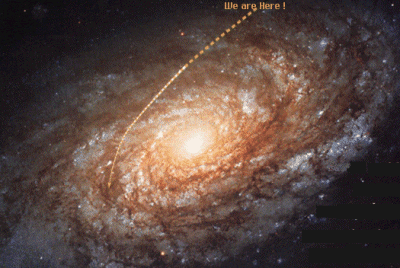
Our Galaxy in infrared (top) and rotated artist conception (bottom).
"The conventional model of how galaxies form is that in the early Universe, gas clouds collapse to form supermassive black holes. Other parts of the gas cloud then swirl into orbit around the black holes and stars are born. ...
![[IMAGE]](m33.gif)
|
That was until astronomers found a galaxy that is missing a vital component at its heart - a supermassive black hole. The discovery challenges the prevailing view that these black holes are crucial to galaxy formation. ... Galaxy M33 may be the first hard evidence that astronomers have been getting the chicken and egg the wrong way round. "M33 looks like a fairly young galaxy," he says. He thinks it is possible that a supermassive black hole may yet form in M33, although astronomers are not sure whether this would be typical. Others disagree, and are glad that, despite the confusion, one aspect of the current model survives intact, the relationship between the galactic bulge and the mass of the black hole. And propose that the solution to the problem will come from understanding better how the unusual, bulgeless disc galaxies form."
(from "Missing black hole forces galaxy rethink" 19:00 19 July 01 http://www.newscientist.com/news/news.jsp?id=ns99991049)And, obviously no one has, or ever will:
a) observe or measure a "NOTHING" without space-time.
b) observe or measure a "singularity".
c) observe a "singularity" expand or shed a membrane.
d) or know which came first, the universe, or the laws determining its forming?
Is there then sufficient cause for theoretically running the "expansion" backwards, and conclude that there MUST have been a point in time when all the matter of the universe was together in an arbitrarily small volume which sprang into existence as a random quantum fluctuation of NOTHING?
"Cosmology writer Marcus Chown concedes it will
be extremely difficult to finally prove
any model of the universe. He is refreshingly honest about the problems involved: "The
history of cosmology is the history of us being completely wrong," he told the BBC.
"I mean, cosmology is the hardest of all sciences; we sit on this tiny planet in the
middle of this vast universe, we can't go anywhere and do any experiments - all we
can do is pick up the light that happens to fall on us and deduce some things about
the universe." ...(from "An alternative to the Big Bang:" by Alan Woods)
Yet despite this, scientists continue to probe the secrets of the universe and nature,
wrestling with one result after another. (Granted, it is very interesting stuff,
a fruitful field for those with good imaginations.)However, what is clear to some scientists is that the deficiencies of the Big Bang theories are now becoming more evident, and the search is on for alternatives, thus the appearance of new theories most every year! Consider the following "NEW" "Cyclic Universe" theory:
"the cyclic universe - ... In this picture,
The big bang is not the beginning of time.
reinvigorates ancient cosmic mythologies and philosophies,
albeit using the tools of 21st century physics."
And in the near future we expect many more NEW theories !
"If you are not completely confused by quantum mechanics,
you do not understand it".
The same may be said for general relativity,
and also the concept of NOTHING,
if there ever was a NOTHING?
and how we get SOMETHING from NOTHING!
